6 Yoga Poses for Relieving Back Pain

But why yoga? Because it’s a discipline that uses different poses to strengthen your muscles and make your tendons more flexible. In other words, it’s a great way to combat the stiffness you might start to feel when you spend multiple hours sitting in a chair, shelving high-up products, or standing at a hotel reception desk, to give some examples.
Yoga as a treatment
Yoga is an age-old technique that unites body and mind, with an added splash of religiousness (or faith) added. But not too many years ago people started to use it to achieve a mind-body balance, without worrying about the other parts. There are many different variations of yoga, and you can use them as a complement to treatments for all kinds of mental and physical problems.
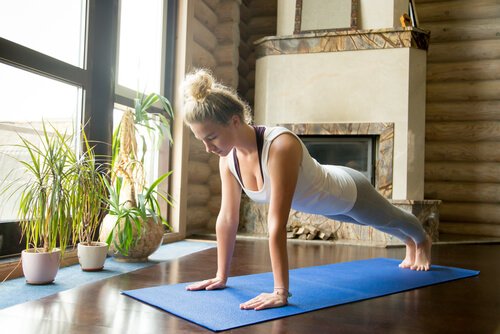
Just remember that it’s not a medical treatment, and you should consult your doctor before you try it. Still, yoga is a great addition to a lot of treatments, especially if you’re trying to get an overworked part of your body back to normal. That’s why it’s so important to make a good choice about where you’ll practice your yoga poses, along with letting your instructor know your limitations from the beginning.
Thanks to the the internet there is lots of yoga information online. Even if the person in the video is a professional, it’s best to have them there with you to correct mistakes.
With that in mind, we feel there are some simple yoga poses that you can start off with. We’re going to show you six of them in this article, classified by which part of your back you feel the pain in. But before you jump into it, just remember that you usually get the most benefits out of yoga when you do it often, when your doctor has told you you’re fit enough for it, and when you have a qualified trainer supervising you.
Doing yoga to relieve back pain is beneficial in many ways, as long as you do it consistently and under the supervision of a qualified trainer.
Yoga poses for relieving upper back pain
Upper back pain, or dorsalgia, shows up in your trapezius, levator scapulae, and dorsal muscles, among others. It’s usually caused by bad head posture, which puts a lot of extra weight on your spine and neck.
People who work sitting down in offices and students who spend a lot of time at their desks are two of the main groups at high risk for this kind of pain. They can benefit immensely from the following yoga poses.
1. Cat pose and cow pose
This yoga pose for relieving back pain is made to contract and stretch every muscle in your back, but it’s especially good for pain in the thoracic spine. The pose gets you to stretch muscles that you put constant tension on without ever giving them a break. In other words, you use them to hold up your weight.
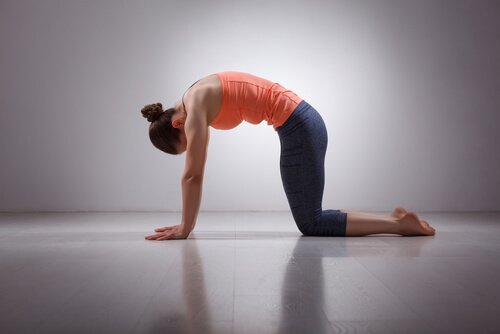
But how do you do it? First, you need to get on your hands and knees. Once you’re there, bend your core upwards and arch you back as much as you can (cat pose). Next, you’ll do the opposite of that movement and arch your back downwards (cow pose). You can repeat these motions as many times as you want, as long as you do it in a controlled way.
2. Child’s pose
This is one of the easiest yoga poses. It helps you relax your body completely and stretch your back in a calm, controlled way.
You start this one by sitting down on your calves. Then you stretch out your arms and bring them as far forward as you can. With your arms stills stretched, place your hands on the floor and press down in a firm, relaxed way. If you want to stretch your intercostal muscles (the ones between your ribs) you can put one of your arms under your neck.

Yoga poses for relieving lower back pain
Lower back pain, or lumbago, shows up in your lumbar muscles. It’s also much more common than you might think. Bad posture and problems with the sciatic nerve are two of the big causes. Whether it’s a minor problem or a chronic illness, these two postures can be a huge help.
1. Legs-up-the-wall pose
As simple as it might seem, this pose has some great benefits for circulation and muscle strength.
You do it by laying face-up on the ground with your legs leaning fully against the wall. You can also use a mat or a towel to help you stay in this pose if you need to. The important thing is to keep your legs pointing as straight up as possible.
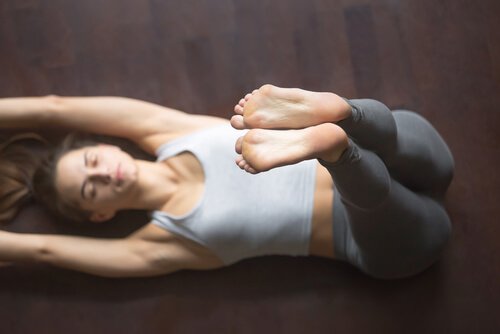
2. Forward fold
You can do this yoga pose standing up or sitting down, and it can help make you much more flexible. Just remember that this one can tend to push your limits, especially if your muscles aren’t warmed up.
Whether you do it standing up or sitting down, the idea is to bend towards your feet and try to touch them. You have to make sure you’re stretching your lumbar muscles as much as possible. It’s extremely important to find a comfortable position with this pose so that you can do it for a longer time. It’s about stretching, not overexerting yourself, so you can rest your hands on your legs once you’ve gotten down as far as you can.
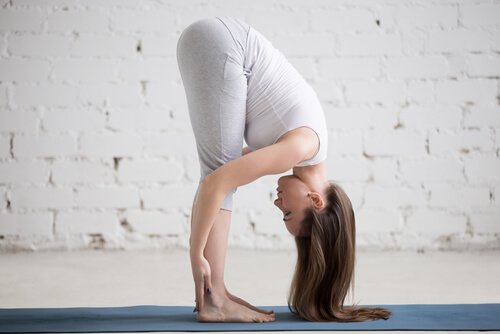
Can yoga prevent back pain?
This age-old technique isn’t just good for relieving current back pain, it can also help prevent it from ever appearing. There are some poses made to strengthen the muscles in specific areas that can help a lot with this.
5. Cobra pose
This pose helps strengthen your lumbar muscles, which prevents you from harming them through bad posture or sudden movements.
You do this laying face-down. Lift your torso upwards as much as you can, using your lower back to push you up. You don’t need bend as much as possible, just however much your back will let you. It’s best to do this pose very frequently so that you can strengthen this area of your body.
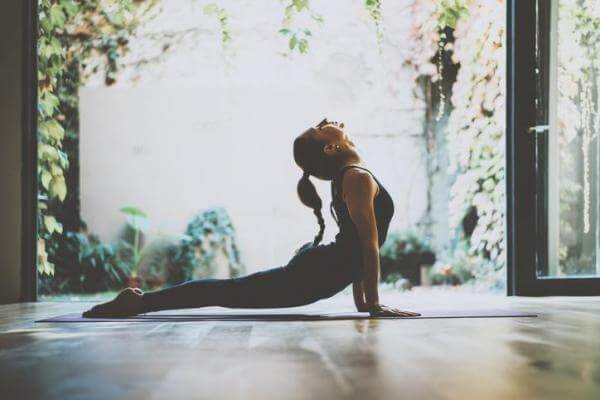
6. Upward facing dog (intermediate level)
This is the hardest of the poses we’ve talked about, and it’s a variation on cobra pose. You need to have stronger, more toned muscles to do it properly.
Once you’re in cobra pose, you lift your chest even more, and then do the same with your hips. You should end up with your hips raised slightly above the floor. But it’s important not to contract your shoulders in this pose–they need to stay spread apart from your neck.
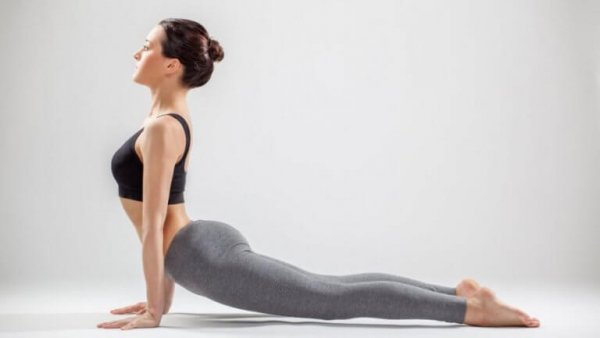
In the end, if you have a strong, resistant back, you’ll probably be able to deal with back pain much better. It’s always good to remember that prevention can be a big help with all kinds of pain, and it can keep you from developing even more in the future.
But why yoga? Because it’s a discipline that uses different poses to strengthen your muscles and make your tendons more flexible. In other words, it’s a great way to combat the stiffness you might start to feel when you spend multiple hours sitting in a chair, shelving high-up products, or standing at a hotel reception desk, to give some examples.
Yoga as a treatment
Yoga is an age-old technique that unites body and mind, with an added splash of religiousness (or faith) added. But not too many years ago people started to use it to achieve a mind-body balance, without worrying about the other parts. There are many different variations of yoga, and you can use them as a complement to treatments for all kinds of mental and physical problems.

Just remember that it’s not a medical treatment, and you should consult your doctor before you try it. Still, yoga is a great addition to a lot of treatments, especially if you’re trying to get an overworked part of your body back to normal. That’s why it’s so important to make a good choice about where you’ll practice your yoga poses, along with letting your instructor know your limitations from the beginning.
Thanks to the the internet there is lots of yoga information online. Even if the person in the video is a professional, it’s best to have them there with you to correct mistakes.
With that in mind, we feel there are some simple yoga poses that you can start off with. We’re going to show you six of them in this article, classified by which part of your back you feel the pain in. But before you jump into it, just remember that you usually get the most benefits out of yoga when you do it often, when your doctor has told you you’re fit enough for it, and when you have a qualified trainer supervising you.
Doing yoga to relieve back pain is beneficial in many ways, as long as you do it consistently and under the supervision of a qualified trainer.
Yoga poses for relieving upper back pain
Upper back pain, or dorsalgia, shows up in your trapezius, levator scapulae, and dorsal muscles, among others. It’s usually caused by bad head posture, which puts a lot of extra weight on your spine and neck.
People who work sitting down in offices and students who spend a lot of time at their desks are two of the main groups at high risk for this kind of pain. They can benefit immensely from the following yoga poses.
1. Cat pose and cow pose
This yoga pose for relieving back pain is made to contract and stretch every muscle in your back, but it’s especially good for pain in the thoracic spine. The pose gets you to stretch muscles that you put constant tension on without ever giving them a break. In other words, you use them to hold up your weight.

But how do you do it? First, you need to get on your hands and knees. Once you’re there, bend your core upwards and arch you back as much as you can (cat pose). Next, you’ll do the opposite of that movement and arch your back downwards (cow pose). You can repeat these motions as many times as you want, as long as you do it in a controlled way.
2. Child’s pose
This is one of the easiest yoga poses. It helps you relax your body completely and stretch your back in a calm, controlled way.
You start this one by sitting down on your calves. Then you stretch out your arms and bring them as far forward as you can. With your arms stills stretched, place your hands on the floor and press down in a firm, relaxed way. If you want to stretch your intercostal muscles (the ones between your ribs) you can put one of your arms under your neck.

Yoga poses for relieving lower back pain
Lower back pain, or lumbago, shows up in your lumbar muscles. It’s also much more common than you might think. Bad posture and problems with the sciatic nerve are two of the big causes. Whether it’s a minor problem or a chronic illness, these two postures can be a huge help.
1. Legs-up-the-wall pose
As simple as it might seem, this pose has some great benefits for circulation and muscle strength.
You do it by laying face-up on the ground with your legs leaning fully against the wall. You can also use a mat or a towel to help you stay in this pose if you need to. The important thing is to keep your legs pointing as straight up as possible.

2. Forward fold
You can do this yoga pose standing up or sitting down, and it can help make you much more flexible. Just remember that this one can tend to push your limits, especially if your muscles aren’t warmed up.
Whether you do it standing up or sitting down, the idea is to bend towards your feet and try to touch them. You have to make sure you’re stretching your lumbar muscles as much as possible. It’s extremely important to find a comfortable position with this pose so that you can do it for a longer time. It’s about stretching, not overexerting yourself, so you can rest your hands on your legs once you’ve gotten down as far as you can.

Can yoga prevent back pain?
This age-old technique isn’t just good for relieving current back pain, it can also help prevent it from ever appearing. There are some poses made to strengthen the muscles in specific areas that can help a lot with this.
5. Cobra pose
This pose helps strengthen your lumbar muscles, which prevents you from harming them through bad posture or sudden movements.
You do this laying face-down. Lift your torso upwards as much as you can, using your lower back to push you up. You don’t need bend as much as possible, just however much your back will let you. It’s best to do this pose very frequently so that you can strengthen this area of your body.

6. Upward facing dog (intermediate level)
This is the hardest of the poses we’ve talked about, and it’s a variation on cobra pose. You need to have stronger, more toned muscles to do it properly.
Once you’re in cobra pose, you lift your chest even more, and then do the same with your hips. You should end up with your hips raised slightly above the floor. But it’s important not to contract your shoulders in this pose–they need to stay spread apart from your neck.

In the end, if you have a strong, resistant back, you’ll probably be able to deal with back pain much better. It’s always good to remember that prevention can be a big help with all kinds of pain, and it can keep you from developing even more in the future.
This text is provided for informational purposes only and does not replace consultation with a professional. If in doubt, consult your specialist.







